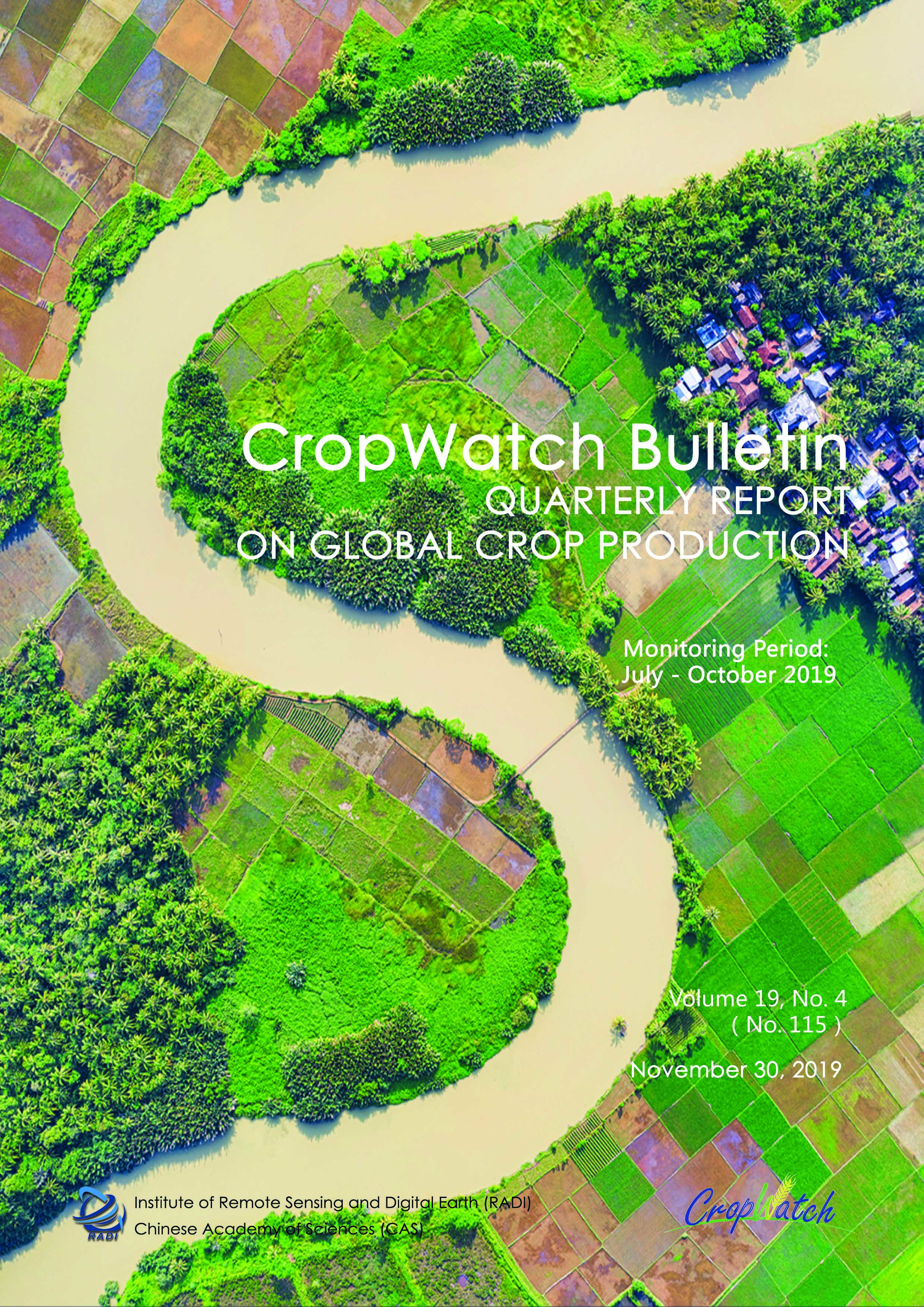
-
The November CropWatch Bulletin is based primarily on current remote sensing data in addition to comprehensive and spatially accurate reference data about crops and their management. The scope is global and comprehensive. Focusing on July to October 2019, chapters cover global, national, and regional agroclimatic conditions and the condition of crops that were growing or harvested during this time. For China, the bulletin presents crop production, crop condition for each of seven major agro-ecological zones, the regional impacts of pests and diseases as well as trade prospects (import/export) of major crops. The focus section reports on food production estimates, recent disaster events with an impact on agriculture, and the possibility of an El Niño event.
Key messages from the report:
- Global agroclimatic conditions: current reporting period was globally warm and dry. On a continental basis, RAIN anomalies were largest in Oceania (down 38% compared with average). Low precipitation in southern and especially central America (-9%) is directly associated with a very tense situation in the “drought corridor”.
- Global Agricultural production estimates: The volumes produced in 2019 include 1055 million tonnes of maize, up 0.5% from 2018, 754 millions for rice (as paddy; up 4.2%), 716 million tonnes of wheat (a 0.9% increase) and 324 million tonnes of soybeans, 1.0% lower than last year’s output.
- China: the total 2019 annual crop production is estimated at 628 million tons, up 2% from 2018. For summer crops (including maize, semi-late rice / single rice, late rice, spring wheat, soybean, tuber crops, and other minor summer crops) the output is put at 467 million tons, a 2% increase
Introduction
This CropWatch bulletin summarizes global crop condition developments and agroclimatic factors from July 1st to October 31st, 2019 through 4 zoom in from a global overview of agroclimatic indicators (Chapter 1) to detailed descriptions of crop and environmental conditions in large production zones (Chapter 2), to individual country analyses covering 42 major producers and exporters including agro-ecological zones (Chapter 3) and China (Chapter 4). A special focus section is included in Chapter 5, presents crop production for 2019, disaster events and an update on El Niño. This first part of the report includes the cover, table of contents, abbreviations, a short overview of the different sections of the bulletin and executive summary.DownloadChapter 1 Global agroclimatic patterns
Chapter 1 describes the CropWatch agroclimatic indicators for rainfall (RAIN), temperature (TEMP), and radiation (RADPAR), along with the agronomic indicator for potential biomass (BIOMSS) for sixty-five global Mapping and Reporting Units (MRU). Indicator values for all MRUs are provided in Annex A.DownloadChapter 2 Crop and environmental conditions in major production zones
Chapter 2 presents the same indicators—RAIN, TEMP, RADPAR, and BIOMSS—used in Chapter 1 and combines them with agronomic indicators—cropped arable land fraction (CALF), maximum vegetation condition index (VCIx), and minimum vegetation health index (VHIn)—to describe crop and environmental conditions in six global major production zones (MPZ): West Africa, North America, South America, South and southeast Asia, Western Europe, and Central Europe to western Russia. (See also Annex A for more information about these zones.)DownloadChapter 3 Core countries
Building on the global patterns presented in previous chapters, this chapter assesses the situation of crops in 42 key countries that represent the global major producers and exporters or otherwise are of global or CropWatch relevance. First, the overview section (3.1) pays attention to all countries worldwide, to provide some spatial and thematic detail to the overall features described in section 1.1. In section 3.2, more detail is provided for each of the CropWatch monitored countries, including analyses by key agro-ecological zones within the country. Additional information about indicators per country is provided in Annex A.DownloadChapter 4 China
After a brief overview of the agroclimatic and agronomic conditions in China over the reporting period (section 4.1), Chapter 4 describes the situation by region, focusing on the seven most productive agro-ecological regions of the east and south: Northeast China, Inner Mongolia, Huanghuaihai, Loess region, Lower Yangtze, Southwest China, and Southern China (4.2). Additional information on the agroclimatic indicators for agriculturally important Chinese provinces are listed in table A.11 in Annex A.DownloadChapter 5 Focus and perspectives
Building on the CropWatch analyses presented in chapters 1 through 4, this chapter presents first early outlook of crop production for 2019 (section 5.1), as well as sections on recent disaster events (section 5.2) and an update on El Niño (5.3).DownloadAnnex A Agroclimatic indicators
Tables in this Annex provide additional information about the agroclimatic indicators—RAIN, TEMP, and RADPAR—as well as BIOMSS for the various CropWatch spatial units. Those units include the Monitoring and Reporting Units (MRU); the forty three main producing and exporting countries; and regions or provinces within large countries—Argentina, Australia, Brazil, Canada, India, Kazakhstan, Russia, and the United States; and China.DownloadAnnex B Quick reference guide to CropWatch indicators, spatial units and methodologies
Annex B presents a brief overview of the CropWatch indicators and spatial units (including the MRUs, MPZs, and countries), along with a description of the CropWatch production estimation methodology and methodology to determine the severity of the occurrence.Download

